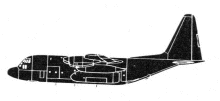Incident Overview

Description
A Lockheed C-130H Hercules (88-4404) and C-27J were involving in a mid-air collision accident near Mackall AAF, North Carolina. Both aircraft were damaged but landed safely, there were no injuries. The C-130H Hercules, PACKR32, was scheduled for a local tactical training flight out of Fayetteville-Pope AAF. The C-27J, GECKO33, also operated on local training flight with traffic patterns and simulated air drops. At the time of the incident, the C-130 was performing an escape maneuver to egress Luzon Drop Zone (DZ) following completion of a visual Container Delivery System airdrop. The C-27 was departing Laurinburg-Maxton Airport enroute to two waypoint DZs for simulated airdrops. The C-130 was leveling at 1500 feet Mean Sea Level (MSL) on a heading of 193 degrees while the C-27 was level at 1500 feet MSL, on a heading of approximately 310 degrees passing slightly beneath the C-130 from left to right. The right wingtip of the C-27 grazed the right underside of the C-130 at the nose gear door, damaging the gear door and following a path that tore the flare dispenser hood from the fuselage and then proceeded beneath the C-130’s right wing. The C-27 vertical stabilizer crossed immediately in front of the nose of the C-130 and proceeded between the prop arcs of the C-130’s number 3 and 4 engines. The vertical stabilizer then came into contact with the front of the C-130s right external fuel tank and continued on a path impacting midway down the inboard side of the number 4 engine and leading edge of the right wing in the vicinity of the engine mount. The C-130 sustained damage to the leading edge of the right wing and number 4 engine. The C-27 sustained significant damage to the top third of the vertical stabilizer and rudder. The Accident Investigation Board President found by clear and convincing evidence that the cause of the mishap was a breakdown in visual scan resulting in insufficient clearing of the aircraft flight path by both aircrews. The AIB President found that both aircrews were overreliant on Traffic Collision Avoidance Systems to alert them to potential traffic conflicts and concentrate their visual scan. Additionally, the AIB President found that both aircrews exhibited complacency due to the routine nature of the mission profiles, despite the inherent risk associated with night, low-level, visual flight rules operations on Night Vision Goggles. The AIB President further found that the visibility afforded by the C-27 is limited, presenting a considerably obstructed view for the left-seat pilot who was flying, limiting his ability to see the C-130 approaching from the right with sufficient time to avoid collision. Lastly, the AIB President found the pilot flying from the left seat of the C-130 channelized his attention on aircraft control resulting in a loss of situational awareness and breakdown of visual scan outside the aircraft.
Primary Cause
A breakdown in visual scan leading to insufficient clearing of the aircraft flight path, compounded by overreliance on Traffic Collision Avoidance Systems (TCAS), complacency due to routine mission profiles, limited visibility afforded by the C-27, and pilot attentional lapses due to channelized attention on aircraft control.A breakdown in visual scan leading to insufficient clearing of the aircraft flight path, compounded by overreliance on Traffic Collision Avoidance Systems (TCAS), complacency due to routine mission profiles, limited visibility afforded by the C-27, and pilot attentional lapses due to channelized attention on aircraft control.Share on:





